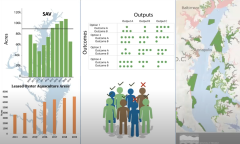Knauss legislative fellowships in Congress help build careers — and they're fun and educational. See our video and fact sheet for details.
Connecting Research with New Audiences During COVID-Times
This past fall, University of Maryland’s annual Marine Estuarine Environmental Sciences (MEES) colloquium looked a little different. Like so many 2020 plans, the gathering of students, professors, and administrators moved from its planned location at University of Maryland Center for Environmental Science’s Chesapeake Biological Laboratory in Solomons Island to a day-long Zoom conference.
In order to present student research in this new format, each MEES Graduate Program Foundation area invited a single student, or panel of students, to showcase their work to the department. As a master’s student in the Interdisciplinary Environment and Society foundation, this offered me the opportunity to present, as part of a panel, a three-minute thesis of my ongoing research valuing shallow-water services in the Chesapeake Bay.
My approach uses decision science and evaluation techniques to understand which benefits of shallow water estuaries are important to people, and how future policy–particularly regarding oyster aquaculture–might incorporate those values.
Here is my presentation:
While the MEES program has always held classes virtually to accommodate the geographic spread of our students, it was difficult to adjust to our annual in-person event going virtual as well. In addition to my ever expanding list of literature to read, people to contact, and concepts to map, it took a strong push of motivation on my end to shorten the concepts and questions I spend every day thinking about down to just three minutes, and then once again talk to my computer screen.
However, I am so glad I put the effort into this recorded three minute presentation, and plan to record more, even without a live audience. Since recording my talk in early October, I have been able to reach nearly 800 viewers on LinkedIn alone, an outreach effort I could never have achieved within my networks through presentations and word of mouth. And, because it was short, practiced, and polished, people from all throughout my life engaged with it, not just my professional peers.
As a researcher, it can be easy to get caught in the minutia of the questions we think about every day. And, as everyone copes with life during COVID, online platforms are full of potential audience members looking for a quick distraction from all of the other stresses right now. I am excited to record my next three-minute thesis, not just to see how my work continues to change, but to keep my networks caught up on what I’m up to, and expect that even in post-COVID times, this practice may be one that I stick with.
Photo, top left: Screen capture from Megan’s virtual presentation.
See all posts to the Fellowship Experiences blog

